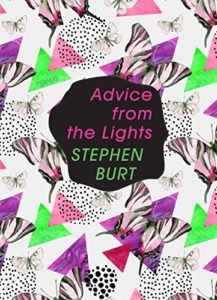Like Sand, and Solid Ground
by Mattilda Bernstein Sycamore | Contributing Writer
—
This essay is part of a series in which Poetry Northwest partners with Seattle Arts & Lectures to present reflections on visiting writers from the SAL Poetry Series. Stephanie Burt reads at 7:30 p.m. on Monday, October 9 at McCaw Hall.
—
In Advice from the Lights, Stephanie Burt’s new poetry collection (Graywolf, 2017), we hear from a variety of unlikely speakers: a hermit crab, a betta fish, a roly-poly bug, a herring gull, a water strider, a pair of ferrets, a secondhand flashlight, white lobelia flowers, kites, the Egyptian god Anubis, and even a “Fuzzy Golem Doll with 6” Keychain” at a Prague synagogue.
The Golem doll says, “I want to be chosen.”
The roly-poly bug says, “I answer the most banal // questions by quoting the questioner.” The herring gull adds, “I want to persuade myself that I don’t care.”
Anubis, the god of the afterlife, often pictured with the head of a dog, waxes philosophically: “Dog lovers, I have learned, have feline souls, requiring / companionship they cannot ‘find within.’ ”
The ferrets, in captivity, make circular arguments into circular shapes. And white lobelia hangs out, or hangs, in the garden store, gossiping with the petunias.
Personification plays an active role in Advice from the Lights, starting with the first poem, where a chunk of ice tells us, “I grew up in the human world,” and immediately becomes human, or feels human, or humanly. There is humor in these poems; pathos, insight, and charm; rhyme with and without reason; a sense of place and a place for sense. There is order, but also, at times, a slipperiness to the “I” that opens into a doubling of character and intent.
In “Hermit Crab,” the literal becomes figurative, and the figurative becomes literal:
Each home is a hideout; each home is a secret; each home
is a getaway under the same hot lamp, a means
to a lateral move at low velocity.
When the hermit crab says, “I live in a room in the room / of a boy I barely see,” we see the boy who sees the hermit crab. A memory, or potential memory, of childhood hopefulness and claustrophobia hovers beneath this observation. The hermit crab prompts joy toward the mysterious creature’s metamorphosis, but sadness at its death, along with a final, inevitable realization: “if I have a body that’s wholly my own / then it isn’t mine.”
In “Concord Grapes,” one of the final poems in the book, Burt asks:
What would it be like to belong
entirely in your own body, or in your own country, or at
your own address?
This is a central question in Advice from the Lights. There are the poems that explore a particular year of the author’s life, from 1979 to 1987, and then there are the poems that conjure a girlhood for the author that was not allowed. A girlhood where Stephen can be Steph or Stephanie, where this is uncomplicated, not where “I painted all ten of my toenails with Liquid Paper / then followed my father’s injunction and scraped it all off.”
Instead, in “Esprit Stephanie,” Burt imagines wearing lemon-yellow leggings and “Sweatshirts big enough to hide half a person,” the uniform of 1983 teen and tween girls. No longer limited to craving access to fashion choices disallowed by restrictive gender norms, “The hard work of appearances disappears.” But this doesn’t mean there isn’t hard work. Burt contemplates the possibilities, but doesn’t romanticize them. The poem ends:
I would like to compare my own growing up
to sand, and you and you to solid ground
Advice from the Lights feels like sand, and solid ground. The Stephanie poems are poems for girls who were not allowed to be girls. They are dreamy and soft, like those sweatshirts, but not idyllic. “Tiara Stephanie” starts, “If the root / of experience is humiliation,” and humiliation is rarely comfortable, but here it’s offered as something chosen and transformed. This is not the humiliation of a girl who is not supposed to be a girl, but instead, one who ponders: “What is the root of mystery?”
In the final Stephanie poem, or at least the one where she’s taking her final exams, Stephanie asks:
What is this air, this space in which nobody rewards
me for conformity,
or punishes me, or keeps
track of my time, what I wear, how I see
myself, or tries to tell me what my name should be?
Here Stephanie may be speaking for herself, and she may be speaking of that place between childhood and whatever comes next, but she may also be speaking of the other Stephanie, the one who writes, in “My 1983,” of giving “ten-minute lunchtime lectures // about linguistics to playground structures.” The advice this Stephanie, or “Steve,” receives from a favorite teacher is to think “about what might be interesting to your friends, / not just about what’s interesting to you.” What do we make of this?
and she may be speaking of that place between childhood and whatever comes next, but she may also be speaking of the other Stephanie, the one who writes, in “My 1983,” of giving “ten-minute lunchtime lectures // about linguistics to playground structures.” The advice this Stephanie, or “Steve,” receives from a favorite teacher is to think “about what might be interesting to your friends, / not just about what’s interesting to you.” What do we make of this?
In the title poem, the “advice from the lights” is “be / a child, or be like a child. You will want for nothing, and will never be heard.” Which resonates with the chunk of ice in the opening poem, which laments, “For reasons I cannot fathom, I weep when it rains.”
We can fathom the reasons. But there’s more to learn—“Advice for Holding Together” tells the reader: “Become your own / indignity.” Is Burt holding childhood together, or breaking it apart?
In “Fifth Grade Time Capsule,” Burt writes:
My answer to everything is “It’s too early to say.”
And yet, just two stanzas later:
The people who pick me up can never be
the same as the ones who put me down.
The double meanings of “pick me up” and “put me down” subtly invoke that awful claustrophobia of youth, but also its vulnerability and wisdom. Perhaps this is the answer to adulthood.
In “My 1982,” Burt writes, “I had a future in the dark,” and this is a future, not just of playing a Putt-Putt miniature golf course where you have to hit the ball through a windmill that blocks you if your timing is incorrect—a metaphor for childhood if there ever was one. This is a future, not just of “a wish to look as if I were watching the stars,” but a future of watching from the stars. What greater lights could there be?
The poems in Advice from the Lights portray childhood as a time “where the object was to figure out the object of the game,” which could also apply to the game of poetry. Here the kitsch of childhood is both subject and object, Playmobil figurines that do not move, and “fusillades of words” that do. The book places itself within a white, upper-middle-class world of domesticity and educational attainment where “Everyone’s dad was a lawyer, or else in government service” while “Everyone’s mom was overseeing additions // to our beige, orange, and air-conditioned kitchens,” and yet there is a sadness underneath the surface, or surfaces, that “matched the crayons that matched our skins.” It’s this lurking melancholy that gives the book its force, the offering of perceived happiness pushed away by the hermit crab that says, “That shell is pretty, but that shell is too small for me.”
Burt doesn’t crack the shell, and doesn’t assume it’s the right home: “When everything is artificial, everything / is equally sincere.” Contentment and discomfort exist side-by-side—they inform one another. Maybe, as in the appropriately titled “Sadder,” “wish-fulfillment / is the hidden / goal of every poem”
except when it is the obvious
goal, in which case the hidden
goal is something like learn
how to live in this world.
—
Mattilda Bernstein Sycamore (www.mattildabernsteinsycamore.com) is the author of a memoir and two novels, and the editor of five nonfiction anthologies. Her most recent title, The End of San Francisco, won a Lambda Literary Award. Sycamore hosts Contagious Exchanges: Queer Writers in Conversation, a reading series at Hugo House that will resume in 2018.

